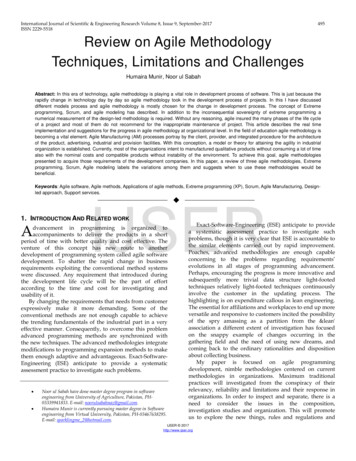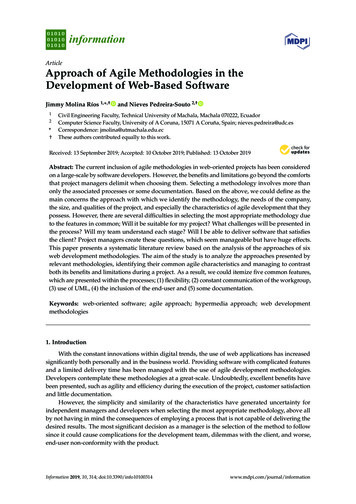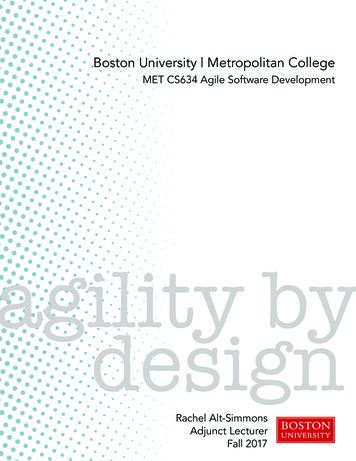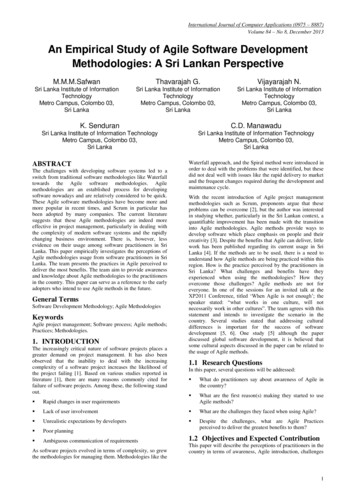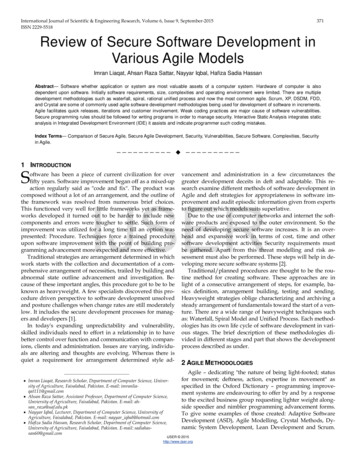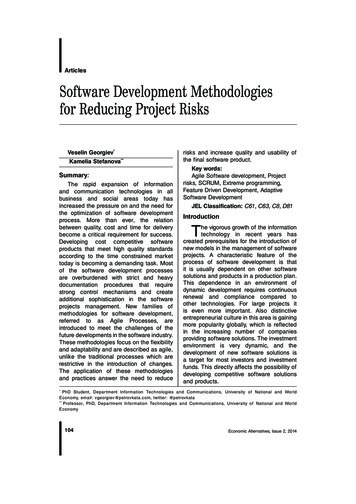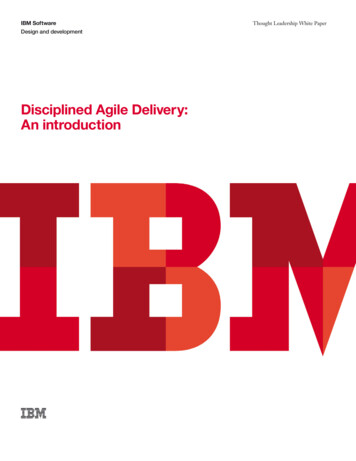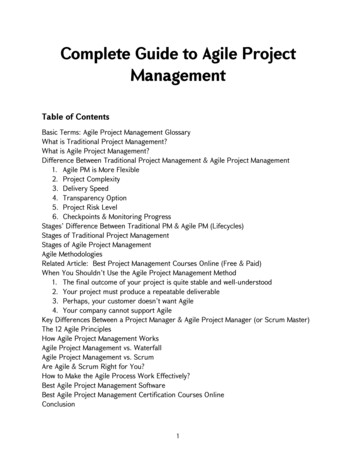
Transcription
Master ThesisSoftware EngineeringThesis no:January 2014Agile Methodologies and Software ProcessImprovement Maturity Models, CurrentState of Practice in Small and MediumEnterprisesVasileios Koutsoumpos – Iker MarinelarenaDept. of Software Engineering (DIPT)Blekinge Institute of TechnologySE-371 79 Karlskrona Sweden
This thesis is submitted to the Dept. of Software Engineering (DIPT) at Blekinge Institute ofTechnology in partial fulfillment of the requirements for the degree of Master of Science inSoftware Engineering. The thesis is equivalent to 10 weeks of full time studies.Contact Information:Author(s):Vasileios Koutsoumpos – 870702-7598Iker Marinelarena – comUniversity advisor:Stefanie BetzDept. of Software Engineering (DIPT)Dept. of Software EngineeringBlekinge Institute of TechnologySE-371 79 Karlskrona, SwedenInternetPhoneFax: www.bth.se: 46 455 38 50 00: 46 455 38 50 57
3Agile Methodologies and Software ProcessImprovement Maturity Models, Current State ofPractice in Small and Medium EnterprisesKoutsoumpos Vasileios, Marinelarena IkerAbstract—Background: Software Process Improvement (SPI)maturity models have been developed to assist organizations toenhance software quality. Agile methodologies are used to ensureproductivity and quality of a software product. Amongst othersthey are applied in Small and Medium – sized Enterprises(SMEs). However, little is known about the combination of Agilemethodologies and SPI maturity models regarding SMEs and theresults that could emerge, as all the current SPI models areaddressed to larger organizations and all these improvementmodels are difficult to be used by Small and Medium – sizedfirms. Combinations of these methodologies could lead toimprovement in the quality of the software products, betterproject management methodologies and organized softwaredevelopment framework.Objectives: The aim of this study is to identify the main Agilemethodologies and SPI maturity models applied in SMEs, thecombinations of these methodologies, and the results that couldemerge. Through these combinations, new software developmentframeworks are proposed. What is more, the results of this studycan be used as a guide with the appropriate combination for eachSME, as a better project management methodology or asimprovement in the current software engineering practices.Methods: A Systematic Literature Review was conducted,resulting in 71 selected relevant papers ranging from 2001 to2013. Besides, a survey has been performed from June 2013 toOctober 2013, including 49 participants.Results: Seven Agile methodologies and six different SPImaturity models were identified and discussed. Furthermore, thecombination of eight different Agile methodologies and SoftwareProcess Improvement maturity models is presented, and as wellas their benefits and drawbacks that could emerge in Small andMedium – sized firms.Conclusion: The majority of the Agile methodologies and SPImaturity models are addressed to large or very large enterprises.Thus, little research has been conducted for SMEs. Thecombinations of the Agile methodologies and SPI maturitymodels are usually performed in experimental stages. However, ithas been observed that such type of combination could presentnumerous benefits, which can also be applicable in SMEs as well.The combinations that are most common are the CMMI and XP,CMMI and Scrum, CMMI and Six Sigma, and the PRINCE2 andDSDM.Index Terms—Agile methodologies, combination, SoftwareProcess Improvement, SMEs, survey, Systematic LiteratureReview.SI. INTRODUCTIONmall and Medium Enterprises (SMEs), are the mostwidespread type of enterprises around the different globaleconomies [7][8] of this rapidly changing world [9], and theycan be resembled as foundation and “motor” of the industrialgrowth [2][10]. SMEs are the enterprises, in which the numberof employees is less than 50, for small enterprises, and lessthan 250 in the case of the medium – sized ones [12].A lot of these SMEs are focusing on developing software.All of these enterprises implement Software Engineeringpractices to a greater or lesser extend in order to develop theirproducts. Software Engineering practices have achieved a lotof importance, because if they are not applied and performedadequately, various problems can arise during the softwaredevelopment [13][14][15].Performing incorrectly the Software Engineering practicescan for example lead to the development of a system thatcontains properties, which were not requested [13]. The majorimpact is the rework that has to be done; it has been provedthat the rework can cost up to 40% of the total project cost[14]. If errors are discovered late in a Software Engineeringprocesses the cost can be 200 times more, than catching themin the early phases of the development process [14][15].As it was mentioned before, this world is changing rapidly;the same happens with software projects. In order to be able tosatisfy the new necessities of the market, Agile methodologieswere implemented, providing enterprises with a group offaster, more flexible, with a continue and easy learning andresponsiveness [2].In addition, applying Agile methodologies is a step forwardin the software development environment, but still there aremany other aspects that are not fully addressed byimplementing Agile methodologies, such as quality assurance,time management, and so forth. Software ProcessImprovement techniques are applied to enterprises in order tofulfill these needs. Their objective is to manage and improvesoftware processes to satisfy the customer’s requirementswithin the time frame at a lower cost, while maintaining thequality of the software product [16][17][18].A. ContributionsThe aim of this thesis project is to identify the current stateof practice of the Agile methodologies and the SPI maturity
4models and as well as their combinations that could be appliedin Small and Medium – sized firms. In order to meet the aim,the following objectives are defined: Investigate:o Search through the literature for theidentification on the most commonmethodologies.o Identify the benefits, challenges anddrawbacks for each methodology. Find out the “real situation” in Small and MediumEnterprises. Compare the Literature and the “real examples”.B. Research QuestionsTo achieve the aims and objectives the following researchquestions will be addressed:RQ1: What agile methodologies combined with SoftwareProcess Improvement maturity models crafted forSmall and Medium Enterprises exist?RQ2: Under which situations and how could thesemethodologies be applied? What are the results – benefits – drawbacksthat each methodology could provide? When should each methodology be applied? What are the reasons for failure?RQ3: Are these methodologies really applied in SMEs?C. Research methodologyDetails of the specific research that were used are presentedin Fig. I.1. The overall goal of the thesis was to identify thecurrent state of practice of the Agile methodologies and theSPI maturity models in Small and Medium sized – firms,which are described not only in articles and books, but also inreal examples, by including practitioners. This goal wasachieved by the research questions described in Table I.1. "! #! "! #! Figure I. 1 Overview of researchTABLE I.1RESEARCH QUESTIONS AND THEIR CORRESPONDING METHODSResearch QuestionRQ1RQ2RQ3MethodologySystematic Literature Review [1]Systematic Literature Review, Survey[1][3]Survey [3]D. Outline of the thesisSection II presents the background of the thesis andprovides descriptions and definitions of the main conceptsused in the thesis. In addition, it identifies the research gapthat this thesis will cover. Section III describes the mostcommon Agile methodologies, the most common SPI maturitymodels and the most common combinations of Agilemethodologies and SPI maturity models, based on the SLR.The SLR is used to answer the RQ1 and RQ2, by providingdetails regarding the way the combinations could be adoptedby SMEs, and as well as their benefits and drawbacks thatcould emerge. Next Section IV presents the results of thesurvey. The survey is used to answer the RQ2 and RQ3, bydescribing what is the “real” situation in enterprises, and ifthese combinations could actually be adopted by SMEs.Section V discusses the threats to validity, concerning thisresearch study. Finally, Section VI concludes the paper, byanswering briefly all the research questions.II. BACKGROUNDVarious papers have been published the last years focusingon the domain of Software Engineering practices and methodsfor improvement [19][20][21][22][23][24]. Through thesestudies, it has been proven that the Software Engineering (SE)practices are performed differently in SMEs, than the waylarger enterprises perform, or the way textbooks describe [25].For example, in SMEs, although different roles exist, they arenot so clear and every employee performs many differentkinds of tasks. Thus, the work is done in a rather informalenvironment heavily relying on collaboration.The literature that exists regarding improvement models forSMEs is limited; this is because SMEs present uniquecharacteristics that originate from their make and ownership[7][25]. SMEs have got specific challenges, due to their sizeand budget under which they operate. In addition, they presentlow maturity levels and fewer resources, in order to considerquality and process improvements. Only a few SMEsdocument their software engineering processes. Kamsties et al.[10] in their study prove that there are not clear ways in SMEs,to perform the software engineering practices properly.Simon et al. [26] show that SMEs do not emphasize ontraining, as they have pressing deadlines, and the time that isavailable for improvement is limited. Instead, SMEs follow asimplified process lifecycle, where they pay particularattention on developing and testing. Even more, they presentlack in control procedures, project management and riskmanagement skills [26]. Mishra et al. [27] present that SMEscannot measure the benefits and the process progress that can
5be derived from such processes.Many Small and Medium Enterprises are willing to improvetheir software engineering processes, in order to developsuccessful software systems [7][27]. However, they find itdifficult to implement these improvement processes, due to thehigh cost that is demanded to implement them. Furthermore,the limited resources and the strict time constraints that theSMEs operate make the adoption of these techniques evenharder [27].What is more, the research in software process is motivatedby the fact that process quality is related with the quality ofthe software product [28][29]. The aim of the SoftwareProcess Improvement is not only to increase product quality,but also to increase reliability, consistency and predictabilityand reduce time to market [28][30].Although several software process improvement techniqueshave been introduced to be applicable in SMEs such as CMMI[31], ISO/IEC 15504 [32], PRINCE2 [33], and so forth, theproblem is that usually all these improvement methods aresuitable only for large enterprises [16]. Changes have to bedone in these methodologies, so that they can fit the SMEsneeds, due to the fact that they operate in strict budget, andthey are highly affected by the customer’s needs [34]. Inaddition, as the conditions in which these techniques can beapplied are not well defined, the benefits that each method canprovide are not well stated [35].Thus, experienced practitioners came up with anotherapproach for improvement. The approach was labeled as Agilesoftware development. This method, presents high impact onhow a software product is developed worldwide [36].However, although the past years many Agile methodologieshave been developed, little is known about how these methodsare carried out in practice and what are their effects [36]. Forexample, Agile methodologies can affect negatively theproject’s main characteristics, such as scope, time, cost andquality [37]. In general, the Agile methodologies suffer fromthe lack of disciplined planning [38].Since, the Software Process Improvement methods areshown to be unsuitable for the SMEs, studies suggest thatSmall and Medium – sized companies can adopt Agiledevelopment methodologies, while following the SPI maturitymodels [39]. Through this new way of working, SMEs cangain a new competitive environment [39]. Thesemethodologies take advantage of the flexibility andadaptability of Agile methodologies, and of SPI methods mainvalue: control [38]. The combination of SPI maturity modelsand Agile methods would be beneficial, since the former tellus what to do, and the latter tell us how to do it [40]. The mainissue is that there are no studies that analyze and compare thedifferent possible models and combinations. For this reason, itis not easy for the SMEs to decide which of these models theycould adopt.In the next section, the structure and the results of theSystematic Literature Review are analyzed and discussed.III. SYSTEMATIC LITERATURE REVIEWThe Systematic Literature Review provides answers to theresearch questions 1 and 2. In order to answer the questions,the findings from the Systematic Literature Review will bediscussed. According to Kitchenham [1][5], an SLR is ameans of identifying, evaluating and interpreting all availableresearch relevant to a particular research question, or topicarea, or phenomenon of interest. Therefore, it could be usefulto a systematic understanding of scientific domain is required.What is more, an SLR could be used to summarize theexisting evidence concerning a specific domain, to identifypossible gaps in current research and to suggest areas offurther research and finally to provide a framework in order toappropriately position new research activities.A. Review questionsThe research questions that will be addressed by this studyare the RQ1 and RQ2 of the thesis. These questions are:“What Agile methodologies combined with SoftwareProcess Improvement maturity models crafted for Smalland Medium Enterprises exist?” and “Under whichsituations and how could these methodologies be applied?,What are the benefits and drawbacks for eachmethodology?, How could they be applied and what arethe reasons for failure?”B. Data Sources and Search StrategyThe process that was used to identify relevant studies anddetails of the search strategy are presented in Fig. III.1. Theprocess was as follows. In the beginning relevant keywordswere identified. Keywords were synonyms for the terms usedin the topic of the thesis and the research questions. Next,search strings were formulated based on the identifiedkeywords. Later, a trial search was performed on the BTH elibraries. If the results were not sufficient, the researchquestions or the keywords were modified. The databases thatwere used were the ACM Digital Library, the IEEE Xplore,the Science Direct and the Inspec.In order to narrow the number of results, filters were usedto find the appropriate papers in the field of SoftwareEngineering or Computer Science. Additionally, the papersthat were collected are from 2001 and later on, due to theAgile Manifesto [41]. Finally, the duplicities were removedwith the help of Zotero [4]. Literature for further reading wasextracted based on the inclusion / exclusion criteria.
6discussing the issues, until they reached an agreement.What is more, papers that were not conference or journalarticles, such as symposium proceedings, sectionintroductions, book chapters were excluded. ' ! ! & # ! " ! ! ! # # ! Figure III. 1 Search strategy to identify the relevant literatureC. Study SelectionDuring the research process, various criteria have beenused. They determined which studies should be included orexcluded.1) Inclusion / Exclusion CriteriaThe choice of studies was based on the inclusion /Exclusion criteria listed bellow. Papers published from 2001 and later on due to theAgile Manifesto [41]. Filters in the databases to limit the results in the fieldof Software Engineering and Computer Sciencedomains. Papers that were not written in English wereremoved. Duplicates were removed with the help of Zotero. Peer reviewed articles were only included in thestudy. The abstract and keywords in a big number of paperswas read. The number of citations that each article had wastaken into consideration as a supporting method. In case of disagreement between the authors, a studyof the articles was performed and then a discussionwas carried out.2) Quality AssessmentOnce the selected articles for the research were gathered,quality assessment had to be performed, based on specificquestions that are presented in Appendix A. Additionally, thequestions were scored as follows: Y (Yes), P (Partially) and N(No). The scoring procedure was Y 1, P 0,5 and N 0, orunknown (i.e. the information is not specified). The articlesthat were scored bellow 5 were excluded from the LiteratureReview. Both the authors performed the scoring procedureindividually and when there was a disagreement, they wereD. Data extraction1) KeywordsThe keywords that were used for search were synonyms ofthe research topic and the research questions. Specifically, thekeywords are described bellow: Agile methodologies, Software Process Improvement, SPI, SMEs, Maturity models.2) Search stringsPilot searches have proved that the keywords listed abovecan provide too broad searching results. Therefore, searchqueries were built from the identified keywords and theirmodifications (e.g. plural form) and Boolean operators such asthe “AND” and the “OR”. The search strings were appliedonly for the Titles and Abstracts.The authors decided initially to search literature for themain Agile methodologies and the main Software ProcessImprovement maturity models. For this reason, they used thefirst two search strings that are listed bellow. Next, theyproceed to the combination, by using the third search stringand to identify the most common models that are referred tothe combinations. After identifying the most commonmethodologies, they proceed to specific literature search, byusing the last three search strings. Specifically, the searchqueries are described bellow: (Agile method*) AND SMEs ((SPI OR software process improvement) ANDmethod*) AND SMEs ((Agile method*) AND ((SPI OR software processimprovement) AND method*)) AND SMEs (XP OR Extreme Programming OR Scrum OR ASDOR adaptive software development OR Leandevelopment OR Dynamic systems developmentmethodology OR Crystal methods) AND SMEs (CMM OR CMMI OR SPICE OR ISO 15504 ORP3M3 OR OPM3 OR PRINCE2) AND SMEs (XP OR Extreme programming OR Scrum OR ASDOR adaptive software development OR Leandevelopment OR Dynamic systems developmentmethodology OR Crystal methods) AND (CMM ORCMMI OR SPICE OR ISO 15504 OR P3M3 OROPM3 OR PRINCE2) AND SMEs3) Search resultsAfter applying the search queries in the BTH e-libraries, thenumber of papers that were found, is presented in thefollowing table.
7TABLE III. 1RELEVANT ARTICLES FOR THE es35264359Due to the fact that many of the relevant studies were foundin more than one database, duplicated findings had to beremoved. The total number of studies that were obtained bythe authors for the needs of the thesis was 71.4) Data collection formThe authors, in order to assist the data collection process,created a form that was applied to all the relevant studies.According to Kitchenham et. al. [1], the use of data collectionforms is proposed, in order to remove bias in the datacollection process.The collection form contained the following data: Article’s title, The research methodology that was used in thearticle, The database that was retrieved, The type of the article (e.g. conference, journal), Publication year, Link to the database, Comments, Quality score.E. Results presentationThis section summarizes the results from the SystematicLiterature Review. The articles that were used for the purposeof the SLR are presented in Appendix B. The authorsidentified articles for the three parts of the thesis, first Agilemethodologies, second SPI maturity models and third thecombination of Agile and SPI. The results of the study arepresented in the subsections bellow.1) Agile methodologiesIn the beginning of the 1990s, many developers found thetraditional methodologies frustrating and sometimesimpossible to apply on the day - to - day more dynamicenvironment [9]. The industry and the technology move toofast, requirements “change at rates that swamp traditionalmethods” [42]. In order to satisfy the necessities of this newenvironment, a group of methodologies that would address thechallenge of an unpredictable world by relying on “people andtheir creativity rather than on processes” [17][43][44] wascreated, the alternative to heavyweight processes: Agilemethodologies [41].On February 11-13, 2001, in Utah, USA, seventeenrepresentatives from Extreme Programming, SCRUM,Dynamic System Development (DSDM), Adaptive SoftwareDevelopment (ASD), Crystal Methodologies, Feature-DrivenDevelopment (FDD), Pragmatic Programming, and otherssympathetic to the need for an alternative to documentationdriven, heavyweight software development processesconvened. What emerged from this meeting was the AgileManifesto, which core ideas are the following [41]: “Individuals and interaction over process and tools, Workingsoftwareovercomprehensivedocumentation, Customer collaboration over contract negotiation, Responding to change over following a plan”. From these core ideas many definitions [45][46] of themeaning of being Agile have been given, but definitelyaccording to these definitions the key attributes of an Agileorganization are: speed, flexibility, learning andresponsiveness [2]. Still, practitioners agree that being Agileinvolves more than simply following the methodology thatmakes a project Agile. Being Agile is more than a collectionof practices; it’s a way of thinking. As is said by AndreaBranca, “many processes may look Agile, but they will not feelAgile” [11, p.2].Through the Systematic Literature Review, the main Agilemethodologies that were identified are the following: Lean Software Development, Scrum, Extreme Programming (XP), Crystal Methodologies, Dynamic System Development Method (DSDM), Feature Driven Development (FDD), Adaptive Software Development (ASD).In the following subsection the results of applying Agilemethodologies on SMEs are analyzed.a)Agile on SMEsThe new environment is forcing enterprises in adoptingAgile methodologies. This can be clearly seen on a 2005survey of the US and Europe, which revealed that 14 percentof companies were using Agile methods, and 49 percent of thecompanies aware of Agile methods were interested inadopting them [60].Many studies have proved the validity of the mainmethodologies. When they are discussing about Agile ingeneral, the main remarked benefits are: the improvedcommunication and coordination [61], greater teamwork andeffectiveness in the rapid production of software that meetscustomers’ requirements [62].It seems that the Agile methodologies are an approach toperfection. But this is not the reality, some practitioners claimthat the studies investigate XP almost exclusively and thatthere is an increasing need for bigger variety (Scrum, Lean,etc.) and better research to determine the validity of thesemethodologies [63][64]. For others, the fact that “there is alack of literature describing projects where Agile failed toproduce good results” [40] attracts their attention. In order totry to make an approach to the reality, some studies state thatseveral research studies have been published on Agileadoption by large enterprises, but the adoption of Agile inregulated environments has not been yet addressed [65] andtherefore Agile methods and regulated environments are oftenseen as incompatible [63].
8It has usually been said that Agile processes are moresuitable for small and low risk projects [40][66] but the issueof best practices within SMEs has always been a challenge[66]. Thus, many practitioners claim that adopting Agilemethodologies has a high cost of implementing new ideas[37][67][68] and still many time tools and techniques areapplied in a wrong way [69].2) SPI maturity modelsSoftware Process Improvement is “a systemic procedure forimproving the performance of an existing process system bychanging or updating the process” [17, p.1][70].Unfortunately, there is no specific SPI model for these firmsas all the current SPI models were developed for large firms,and these improvement models are difficult and in many casesnot suitable to be used by small software development firms,due to the fact that they are too complicated and expensive tobe implemented [8]. However, some researchers indicated thatSPI could be used as a competitive advancement strategy forboth small and large organizations [17][71].Through the SLR that the authors conducted, the mostcommon SPI maturity models are the following: CMM, CMMI, ISO / IEC 15504 or else known as SPICE, PRINCE2, OPM3, P3M3.In the following subsection, the results of applyingSoftware Process Improvement maturity models on SMEs arediscussed.a)SPI maturity models on SMEsThe purpose of the several maturity models for softwareprocess improvement such as the CMM, the CMMI, theSPICE, and so forth, is to provide quality patterns andmanagement frameworks that an enterprise could implementto improve its software development process [8].Unfortunately, it has been observed that the successfulimplementation of such models is generally not possiblewithin the context of Small and Medium – sized softwareorganizations, as they are not capable of bearing the cost ofimplementing these software process improvement programs[17][72][73]. The proper implementation of softwareengineering techniques is a difficult task for SMEs, since theyoften operate on limited resources and with strict timeconstraints [73]. Small companies generally need externalassistance in planning and implementing process improvementto keep abreast of state-of-the-art Software Engineeringresearch and practice [74].Many SMEs have recognized that the need to improve andevaluate their software product alone seems insufficient, sinceit is known that product’s quality is largely dependent on theprocess that is used to create it [75]. Many researchers supportthat SMEs are characterized by lack of resources, lack ofdevelopment and supporting environment, lack of budget anddependency on large organizations [76].Dyba et al. [77] and [17] indicated that SPI maturity modelscan be used as a competitive advancement strategy for bothsmall and larger organizations [77]. Furthermore, Cater andSteel [78] in their study proved that the software processimprovement program was effective in improving the processcapability of many of the SMEs.Today, software industry is one of the most rapidly growingsectors and this situation stimulates especially the constantcreation of small companies, which play an important role inthe economy [73]. In the last few years, a great number oforganizations have been interested in the SPI [8][79].3) Combination of Agile methodologies and SPI maturitymodelsNowadays software industry represents an importanteconomical activity in both developed and underdevelopedcountries [80]. This is the reason why the quality aspect insoftware development products represents one of the mostimportant activities that has been applied, in order to ensurethe software product quality for some years now [80]. Besides,organizations implement these activities to increase the qualityand capability of its processes, products and services [81]. Inthis context, the measurement and analysis process in qualitymodels and standards such as CMMI Dev 1.2 [82] andISO/IEC 15504 [83] are highly adopted by the softwareindustry to provide their software products and services [84].However, in smaller industries such as the SMEs, thedifficulty in adopting them increases, due to the wide of thismodels and standards. As a result, SMEs have a greaterinterest in adopting agile methodologies, which guaranteethem to deliver software according to the capability [84].Some possible benefits of a combination between the Agilemethodologies and the SPI maturity models that could emergefor a SME, would be the improvement in the quality of thesoftware product, more efficient project management methods,clear process of the software development and reduce thedevelopment cost [36][84][85].Although research has been done regarding the Agilemethodologies and the SPI maturity models, little is knownabout their relationship [86]. It is possible to support that theissues on the “marriage” between agile methods and SPIstandards have not been investigated in sufficient depth andbreadth [86].Thus, continuous improvement of organizational softwareprocesses is important in enhancing the capabilities of anorganization. The traditional approaches for organizationalSPI, however, need to be altered to enable the co-existence ofagile projects and organizational SPI [86]. Currently, thereseems to be lack of empirical evidence on how the Agileapproaches for SPI integrate to the organizational SPIactivities. The existing methods for iterative adaptation andimprovement of Agile project teams do not seem to addressthe organizational learning aspects [86].Through the SLR, the most common combinations of SPImaturity models and Agile methodologies that the authorscame up are the following: CMMI and XP, CM
software development. This method, presents high impact on how a software product is developed worldwide [36]. However, although the past years many Agile methodologies have been developed, little is known about how these methods are carried out in practice and what are their effects [36]. For example, Agile methodologies can affect negatively the
